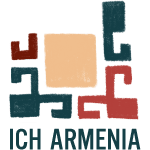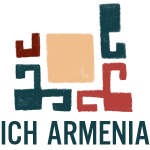
The poetic folklore is branched into the following types: related to the family and daily life routine, family rituals, calendrical holidays, and other groups. Daily family life related folklore is predominantly about love songs. Love songs most vividly reflect and accentuate the buoyancy of the populace. They convey reverence for women and their beauty, or they can conjoin nature and human sentiments. Love songs are created and performed by either girls, or young men, or alternately by both, through dialogues, and often with the help of spontaneous plays. The love theme is also present in workers’ songs, émigré songs, lullabies, etc. The “Jangulum” songs performed at the Ascension festivities are both ritual and romantic in character.
Workers’ songs of the Armenian people are among oldest types of the poetic folklore. For the most part, they contain glorification of work instruments. The latter are either for domestic use, i.e. pertaining to everyday life (milk churning pot, mortar, spinning wheel, spindle, etc.), or related to the field works (ox, cart, wooden plough, cow, buffalo, etc).
Songs related to handicrafts make a separate group. Both domestic lives related and farming/crafts related songs not only praise instruments of labourers and craftsmen but also elicit them as the only means of livelihood and hope for the labourer and his family, capable of sharing their hardships through darker days.
Popular Armenian merrymaking and satirical songs reflect the infinite cheerfulness of our people, its ability to overcome hardships with the help of laughter and humour. They can pointedly exaggerate a loss of petty and unimportant things like shoes or a hen, to ridiculous proportions. Even songs of spinsters (“Tag taneyeen, taneyeen” {I wish somebody married me}, “Qarsoun taris lratsav” {I’m already forty}) manifest to the lifestyle full of good humor. Dance songs, too, date back to historic times and are closely related to various popular rituals and festivities.
Dance songs are divided into labor related ones, military ones, amorous ones, daily life related, etc. They are mostly group dance songs – chain dances accompanied by group or duo singing, and sometimes combining both solo singing and solo dancing. The folklore of the Armenian people is the artistic reflection of its lifestyle. By their content, dance songs are grouped into work-related ones, military ones, amorous ones, daily life related, etc. They are mostly group dance songs – chain dances accompanied by group or duo singing, and sometimes combining both solo singing and solo dancing.
They are mostly group dance songs – chain dances accompanied by group or duo singing, and sometimes combining both solo singing and solo dancing. Our nation has seen times of invasions, mass emigrations and displacements. And émigré songs have become an indispensable part of its life. They either describe the hard life of those who live and work far from their homeland, or are farewell songs of the mother who blesses her son before his departure to foreign shores, or are confessions of love for the family members and homesickness, addressed to birds and breezes.
Armenian daily family life-related folklore has a separate group of popular children’s tales. Depending on the performers, they are either songs related to child care (lullabies, songs sung while bathing a baby, playing with it, watching its first steps, etc), which are sung by adults, or children’s game songs (counting-out rhymes, mocking songs, songs dedicated to nature, the animal world, the celestial bodies, songs were sung while swinging, or horse riding, etc.), which are performed by kids. Some of the children’s folk creations formerly performed by adults, have lost their original function and have passed on to the kids’ domain. These are songs devoted to nature, the celestial bodies, as well as various ceremonial-poetic expressions about droughts, the New Year, or casting of lots, like the “jangulum” songs, etc.
Family ritual songs comprise the ones performed at weddings, births, baptizing, or burials.
Any single stage of the wedding is accompanied by related folk songs, like pre-wedding (meeting the future bride, putting henna on the bride’s hands), the wedding itself (dressing of the bride, praising of the bride and groom, taking the bride away from her family house) and post-wedding songs. The main characters of the wedding songs are the bride and groom, the king and queen, the objects of everyone’s joy and praise. However, the bride is the central figure, hence the focus of admiration and praises. She is compared with natural wonders, such as the sun, the moon, stars, the rainbow, the morning dew and the mystery of the night. In wedding songs the bride is either joyous – she is marrying the man she loves, or she is sad and depressed – her marriage has been forced by the parents. The wedding praises are aimed at preserving the family tree and securing its continuity.
Songs related to burial rituals date back to the primaeval times, and they are called weep songs or mourning songs. They celebrate the virtues of the deceased person, the sweet memories of his/her family life, his/her accomplishments or unfinished plans, the abrupt departure, and they express the grief for the loss, the belief that he/she was on the way to meet other deceased family members in the heaven, etc.
Calendrical ritual folklore embraces the songs and dance songs which have been performed on traditional Armenian holidays: New Year, Christmas, Ter’undez, Barekendan, Tsaghkazard (Palm Sunday), Easter, Vardavar (Transformation) among others. And what’s more, each festivity was provided with songs in tune with the nature of the holiday. New Year songs are full of good wishes for the prosperity of the family, and Ter’undez and Barekendan songs were about love and enchantment, and charms against the evil forces. Easter songs emphasized the fertility of the fields and meadows, and the Hambartsum or casting of lots of songs was being performed while holding a draw to forecast the future for young girls. In Vardavar songs merrymaking and amorous coquetry prevailed, etc.
Everyone, young and old, took part in popular festivities, in singing and dancing, which is why the holidays transformed into all-embracing pageantry and helped to pass on to future generations our songs and dances and popular rituals.
There are other types of poetic folklore, such as urban folk romances, songs of prisoners, soldiers’ songs, non-ritual mourning songs, etc.
Urban folk romances, unlike other works of poetic folklore, belong to later periods. These are songs devised in Middle Armenian, or the popular parlance, that used to be performed in mainly urban environments. The stamp of the author, the individual, is somewhat obvious in them. From the urban lyrical folklore works, the natives and the homeless are among the manifestations of medieval urban folklore. “Hiren” is a folk piece with an authentic Armenian poetic structure, usually containing 15 syllables (7+8). Songs written particularly in that meter are called “hirens”. The variations of hirens, that contained stanzas of 4, 6 or more lines, were called antouni-s. They were usually about émigré life, love and wedding, mourning, etc. They were initially created in Middle Armenian and were popular in the province of Akn. Narekatsi, Shnorhali, Frik and other Middle Age poets wrote their works in the hiren meter.
“Rabis” songs are the product of the newest times. The term is an abbreviation of a Russian definition for the “art of workers” (rabocheye iskusstvo) which has nothing to do with the essence of the songs. Although there are some worthy pieces among “rabis” songs, in general they are exemplified as low-grade art.
Another separate group of the poetic folklore includes songs of convicts, which originated in the previous century. They convey the sadness and gloom of those who are separated from their family and loved ones for a long time, serving their terms in remote places (mainly in Siberia, or Magadan, in the Far East).
Non-ritual mourning songs are interrelated with burial laments. They were born in response to particular tragic events. These are songs of mourning for the loss of people, or the native land, as well as the death of the heroes of the national liberation movement (haydukes), or songs commemorating the times and woes of the Great Patriotic War.
The traditional Armenian military songs are the product of the most recent times. The majority of these songs were created in the 19-20th centuries, and they are devoted to various historic events (the Russian-Persian and Russian-Turkish wars, the national liberation movement) and their heroes. Both the early and later period military songs, albeit possessing some elements of the poetic folklore, are classified by some folklorists in the group of epic songs. Whereas military songs mainly reflect instances of war battles (Russian-Persian, Russian-Turkish, the World Wars I and II) or the national liberation movement and their heroes, the soldiers’ songs convey the sorrowful and cheerless sentiments of those conscribed in the Tsarist Army in Russia.


